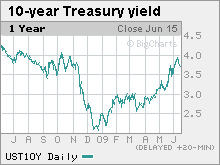Treasury prices rebound
The market gains traction after the Fed purchases $6.5 billion in debt. Reports on inflation and housing ease the flight to safety bid.
NEW YORK (CNNMoney.com) -- Government bonds rebounded from early lows Tuesday after the Federal Reserve bought $6.5 billion in debt as part of its $300 billion buyback campaign.
An afternoon sell off on Wall Street also served to support Treasury prices. Investors tend to shuffle funds into the safe haven of bonds when stocks falter.
The benchmark 10-year note rallied 11/32 to 95-15/32, and its yield dipped to 3.68% after touching 4% last week. Bond prices and yields move in opposite directions.
The 30-year bond rose 1-1/32 to 95-30/32, and its yield fell to 4.5%.
The 2-year note rose 2/32 to 99-12/32, and its yield fell to 1.21%. The yield on the 3-month was 0.17%.
Additionally, the market was waiting to size up the regulatory overhaul that President Barack Obama is set to unveil Wednesday. "Let's hope there are more details in this plan than the one the Treasury Secretary laid out last year," said Kevin Giddis, head of fixed income sales at Morgan Keegan, in his daily research note.
Fed buyback Tuesday: Treasury yields have backed off recent highs, after the 10-year yield hit 4% last week. But yields still remain well above their December lows. Because mortgage rates are tied to Treasurys, the Fed has incentive to keep yields low.
In March, the government announced a $300 billion debt buyback -- or "quantitative easing" -- program to stimulate demand and lower rates.
The Fed has more debt buybacks scheduled this week. On Tuesday, the government bought $6.5 billion of debt that matures between May 2012 and November 2013. On Wednesday, an undisclosed amount of debt maturing between May 2016 and May 2019 is scheduled to be repurchased.
Meanwhile, to snap the economy out of the recession, the government has embarked on an unprecedented spending campaign. To fund those stimulus efforts, the government has been selling a record amount of debt.
On Thursday, the Treasury will announce the size of the 2-year, 5-year and 7-year auctions scheduled for next week.
Housing bounce: A key economic report released on Tuesday showed signs of improvement in the housing sector.
A monthly report from the Census Bureau showed that builders increased their production in May, starting new housing units at an annualized rate of 532,000, up 17.2% from the revised estimate of in April.
The report gave traders reason to believe "the bottom may be forming for the biggest issue of the credit crisis," said Giddis. The multi-family component of the measure is incredibly volatile, but investors were encouraged by the more solid and steady trend higher in single-family homes, he added.
Inflation woes: The deficit-spending campaign to rescue the economy has raised concerns about inflation. Increasing the money supply devalues the dollar, which tends to undermine the value of Treasurys.
Treasurys are particularly sensitive to inflation because the principal investment is fixed, and inflation will devalue that asset, especially over the long term.
However, a government report released Tuesday showed that inflation is not an urgent concern. The Producer Price Index (PPI), which tracks changes in wholesale prices for domestic producers, rose by 0.2% in May, much less than the 0.6% increase that was forecast. The 5% annual rate of decline was the sharpest since 1949.
The PPI report provided evidence that fears of inflation are unwarranted, according to Giddis. He was adamant that without healthy demand, prices will not be able to shoot up.
The Consumer Price Index (CPI), which measures the changes in prices that consumers pay, is due out Wednesday.
Lending rates: Bank-to-bank lending rates have plunged to near record lows in recent weeks, a good sign for the once-frozen pipelines of credit.
The three-month Libor held steady at a record low of 0.61%, according to data on Bloomberg.com. The overnight Libor rate was unchanged at 0.26%.
The London Interbank Offered Rate -- or Libor -- is a daily average of rates that 16 different banks charge each other to lend money. The closely watched benchmark is used to calculate adjustable-rate mortgages. More than $350 trillion in assets are tied to Libor. ![]()



